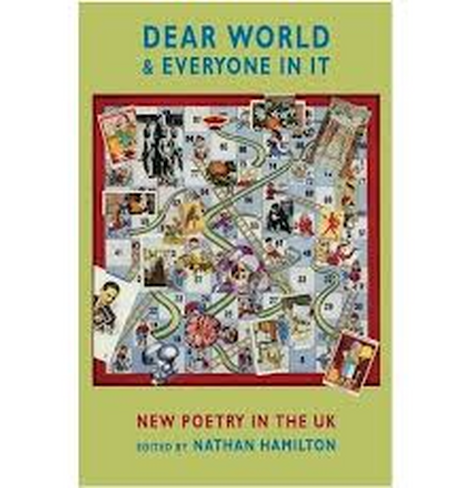Poetry Anthology: Dear World & Everyone In It
Josie Bowerman is impressed by this fantastically eclectic collection of new British poetry.

What happens when the artist becomes the curator? How does the creator become the gallerist? In Dear World and Everyone In It, Nathan Hamilton, himself a poet, now sets out to be a collector of poets: the young writers who are his contemporaries in a new youthful British poetry scene. He has given himself an empty gallery to fill and, in looking to the young and the current, has taken away any previous examples to follow.
When expressly attempting to showcase the new, the temptation could easily be to shock, with uncomfortable and unconventional poems or ways to experience poetry. However, what is striking about Hamilton’s editing is the sense of harmony, beginning with the very layout of the collection. In this gallery of words, there are no bare walls. The book is one to be explored, with something around every corner, not just abandoned exhibits of words and pointless diversions that leave you lost and unable to find your way back to the collection. Instead, pages are filled with snippets and flashes to catch the mind’s eye and make new use of space, in turn helping the reader to rethink how we use books and their traditional format. A mood of freshness comes immediately from how the words are arranged on the pages. The poems and their layout reinforce each other’s message: this is new; this is what can be done with a familiar medium. This is what now is like.
What is especially unique is the selection process behind Dear World’s choice of exhibits. Hamilton encouraged young poets- both British born and bred, and British-based- to recommend their own favourite writers producing poetry now, with a rough age limit of around 35. Hamilton is keen to move away from the style of the ‘Old Editors’ and aims to avoid a prescriptive edit which displays his opinions on what British poetry should be. Consequently the poems included are incredibly varied, of all styles from modernist plays on structure to long prose poems. There is a sense that Hamilton is trying to show the broadest range of writing he can, but this never seems discordant. Instead, the atmosphere is of a group brought together by being different, united by a time and a place and an age, and a common medium to express countless individual thoughts and styles.
Nevertheless, the collection is uncompromising in its dedication to plurality, its refusal to say what poetry is and how a poet should be. The reader can take from it what they wish, and Hamilton is explicit in his desire to reach an audience which is not defined a priori, but which is a shifting and ever-changing mass that forms in the moment of the encounter with the poems in his collection. He presents poems which will not bend for anyone, poems that the audience will shape themselves around.
There is no wasted space in this exhibition. Every poem included not only contributes to a sketch of the scene- bold pencil lines marking the issues and preoccupations currently expressed in poetry- but also to an individual portrait of each poet which is deep with colour and busy with life. As curator, Hamilton has put together a National Portrait Gallery of poems. It’s a collection of people, who just so happen to be young and writing poetry in Britain now, but who all have unique voices and visions. His editing gives the reader a whole world, fully and diversely peopled. Yet more impressively, the reader doesn’t even realise. Hamilton’s presence is so subtle that his gallery is a place to get lost in and truly inhabit, forgetting it is a created space at all. He called ‘Dear World’ and a world sprang up to meet him, a universe to enter and become part of. While certain poets might stand out for this reader, such as Emily Berry and Jo Crot, it seems impossible to recommend a highlight. Standing at the door to this gallery, the only thing to do is step right into the collection. Everyone will experience the world differently and, as the anthology’s title suggests, should embrace it, and everyone in it.
 Interviews / ‘People just walk away’: the sense of exclusion felt by foundation year students19 April 2024
Interviews / ‘People just walk away’: the sense of exclusion felt by foundation year students19 April 2024 News / Climate activists smash windows of Cambridge Energy Institute22 April 2024
News / Climate activists smash windows of Cambridge Energy Institute22 April 2024 News / Copycat don caught again19 April 2024
News / Copycat don caught again19 April 2024 News / John’s spent over 17 times more on chapel choir than axed St John’s Voices22 April 2024
News / John’s spent over 17 times more on chapel choir than axed St John’s Voices22 April 2024 News / Fitz students face ‘massive invasion of privacy’ over messy rooms23 April 2024
News / Fitz students face ‘massive invasion of privacy’ over messy rooms23 April 2024





